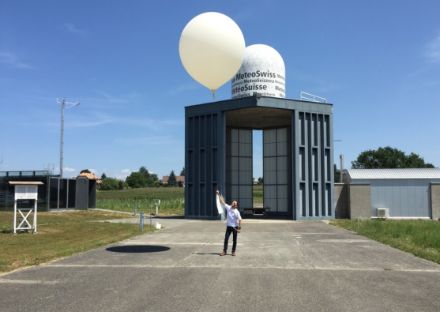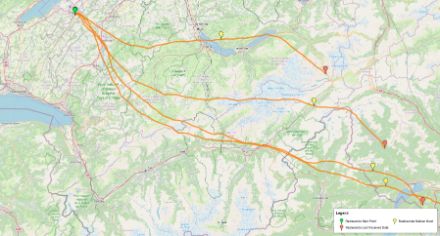Service Navigation
Search
Weather balloons are used to release radiosondes into the atmosphere. The sondes house a collection of measuring devices. This instrument box measures temperature and air humidity. In addition, the weather balloons are equipped with GPS to enable them to determine altitude, flight path, wind speed and wind direction. A radio transmitter allows the measurement data to be transmitted in real time.
MeteoSwiss releases a weather balloon twice a day: From Monday to Friday, the balloons are launched manually at 11 AM UTC, and automatically at the same time at weekends; the second launch at 11 PM UTC is always automatic. The sounding station is located in Payerne, where data from the atmosphere has been collected since the 1940s.
The hydrogen-filled weather balloons ascend at a speed of around five metres per second, taking approximately two hours to reach an altitude of 30-35 km.


Indispensable data for weather forecasts and climatological studies
Radiosondes measure temperature and humidity. Their precise position is recorded using a GPS system, from which the altitude, air pressure, wind speed and wind direction can be determined.
During the ascent, measurements are taken every second and transmitted to the ground-level weather station in Payerne. This enables the weather balloons to provide a very accurate picture of the thermodynamic conditions in the different atmospheric layers. The data obtained in this way is of great importance for weather forecasts and climatological studies.
The paths of the weather balloons
Weather balloons ascend and are carried by the prevailing winds. At an altitude of approximately 35 kilometres, the balloon bursts and the instrument box floats back down towards the ground attached to a parachute.
Numerous balloon launches take place on a daily basis around the world. The balloons can travel several hundred kilometres. Weather balloons all around the globe can be tracked live on the Radiosonde Tracker and https://sondehub.org/ websites.

What to do if you find a radiosonde
Anyone coming across a radiosonde outdoors is asked to take it home with them to help keep the environment free of electronic debris. A label on the radiosonde shows the URL of a website with instructions on how to return the device to MeteoSwiss or recycle its components.